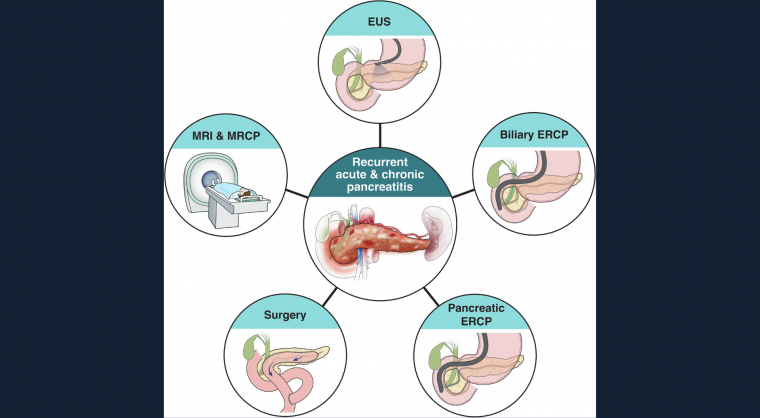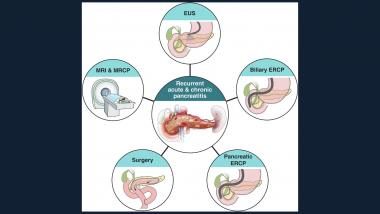AGA has released a new Clinical Practice Update providing best practice advice on the endoscopic approach to recurrent acute and chronic pancreatitis.
Best Practice Advice
- After an unrevealing initial evaluation, endoscopic ultrasound is the preferred diagnostic test for unexplained acute and recurrent pancreatitis. Magnetic resonance imaging with contrast and cholangiopancreatography is a reasonable complementary or alternative test to endoscopic ultrasound, based on local expertise and availability.
- The role of endoscopic retrograde cholangiopancreatography (ERCP) for reducing the frequency of acute pancreatitis episodes in patients with pancreas divisum is controversial, but minor papilla endotherapy may be considered, particularly for those with objective signs of outflow obstruction, such as a dilated dorsal pancreatic duct and/or santorinicele. There is no role for ERCP to treat pain alone in patients with pancreas divisum.
- The role of ERCP for reducing the frequency of pancreatitis episodes in patients with unexplained recurrent acute pancreatitis and standard pancreatic ductal anatomy is controversial and should only be considered after a comprehensive discussion of the uncertain benefits and potentially severe procedure-related adverse events. When pursued, ERCP with biliary sphincterotomy alone may be preferable to dual sphincterotomy.
- Surgical intervention should be considered over endoscopic therapy for long-term treatment of patients with painful obstructive chronic pancreatitis. Endoscopic intervention is a reasonable alternative to surgery for suboptimal operative candidates or those who favor a less invasive approach, assuming they are clearly informed that the best practice advice primarily favors surgery.
- When ERCP is pursued, small (≤5mm) main pancreatic duct stones can be treated with pancreatography and conventional stone extraction maneuvers. For larger stones, extracorporeal shockwave lithotripsy and/or pancreatoscopy with intraductal lithotripsy may be required.
- When ERCP is pursued, prolonged stent therapy (6–12 months) is effective for treating symptoms and remodeling main pancreatic duct strictures. The preferred approach is to place and sequentially add multiple plastic stents in parallel (upsizing); emerging evidence suggests that fully covered self-expanding metal stents may have a role for this indication, but additional research is necessary.
- ERCP with stent insertion is the preferred treatment for benign biliary stricture due to chronic pancreatitis. FCSEMS placement is favored over multiple plastic stents whenever feasible, given similar efficacy but significantly reduced need for stent exchange procedures during the treatment course.
- Celiac plexus block should not be routinely performed for the management of pain due to chronic pancreatitis. The decision to proceed with celiac plexus block in selected patients with debilitating pain in whom other therapeutic measures have failed can be considered on a case-by-case basis, but only after discussion of the unclear outcomes of this intervention and its procedural risks.
Watch author, Dr. Dennis Yang, share his key takeaways from this Clinical Practice Update:
Read the complete AGA Clinical Practice Update on the Endoscopic Approach to Recurrent Acute and Chronic Pancreatitis: Expert Review published in the October issue of Gastroenterology and authored by Drs. Daniel S. Stand, Ryan J. Law, Dennis Yang and B. Joseph Elmunzer.













